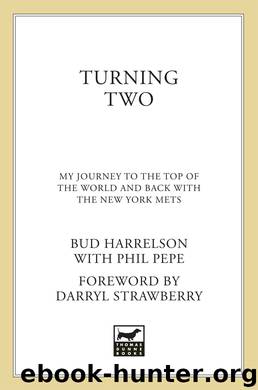Turning Two by Bud Harrelson Phil Pepe

Author:Bud Harrelson, Phil Pepe
Language: eng
Format: epub
Published: 2019-04-20T16:00:00+00:00
CHAPTER 2
“Hey, you swing pretty good left-handed. I like it. Why don’t you try it?”
The gruff, gravelly voice was unmistakable. If you’ve heard it once, you never forgot it, and I had heard it more than once; a lot more. That voice belonged to the one and only Charles Dillon (Casey) Stengel.
This was Huggins-Stengel Field, the New York Mets’ spring training facility in St. Petersburg, Florida, early one morning, practically the crack of dawn, in the spring of 1966. Stengel was there not as the manager of the Mets (he had announced his retirement the previous August) but as an adviser and an interested spectator.
Dating back to his playing days, which spanned 1912 to 1925 with five teams, the Brooklyn Dodgers, New York Giants, Pittsburgh Pirates, Boston Braves, and Philadelphia Phillies, Stengel was one of the most unforgettable and most colorful characters in baseball history. As a player, he was underrated in baseball lore, but not in his time. Born in 1890 in Kansas City (thus the nickname Casey), he was a lifetime .284 batter in 14 seasons and a .393 hitter in three World Series.
Later as a manager, he was a disaster. In nine years at the controls of the Dodgers and Braves (known at the time as the Bees), he had one winning season and never finished higher than fifth place. When the Bees fired him in 1943, Stengel went back to the minor leagues to manage, first for Milwaukee and Kansas City in the American Association, then to the Oakland Oaks of the Pacific Coast League, where he finished second, fourth, and first in three seasons.
In 1949, the Yankees shocked the baseball world by naming Stengel their manager. He was fifty-eight years old and came with a reputation as a clown (he once came to bat, lifted his cap, and a sparrow flew free), yet he stayed for twelve years as manager of the Yankees, won ten pennants and seven World Series, and then was let go after the 1960 season for, as Casey said, “making the mistake of turning seventy years of age.”
When the Mets entered the National League as an expansion team in 1962, they named Stengel their manager. He was obviously there to provide name value and as a promotional distraction since the fledgling Mets were going to be a woefully inept team.
I thought the way the Mets went about stocking their team in 1962 was brilliant. Expansion teams were stocked differently then than now. Back then, expansion teams were in a no-win situation. They were getting other people’s rejects. What the Mets did made sense, selecting players with major league résumés, recognizable names, and some connection to New York, even if those players were past their prime. But it meant the Mets were going to put a team on the field that had no chance to be successful, and Stengel understood that better than anybody else.
If Casey was a failure as a manager with the Mets, he was a rousing success as a salesman, promotional tool, and pitchman.
Download
This site does not store any files on its server. We only index and link to content provided by other sites. Please contact the content providers to delete copyright contents if any and email us, we'll remove relevant links or contents immediately.
| Baseball | Basketball |
| Boxing, Wrestling & MMA | Football |
| Golf | Hockey |
| Soccer |
Imperfect by Sanjay Manjrekar(5804)
Wiseguy by Nicholas Pileggi(5671)
The Body: A Guide for Occupants by Bill Bryson(4974)
Tuesdays with Morrie by Mitch Albom(4692)
Unstoppable by Maria Sharapova(3484)
Not a Diet Book by James Smith(3336)
Crazy Is My Superpower by A.J. Mendez Brooks(3329)
Into Thin Air by Jon Krakauer(3312)
The Mamba Mentality by Kobe Bryant(3189)
The Fight by Norman Mailer(2848)
Finding Gobi by Dion Leonard(2783)
Tuesdays With Morrie by Mitch Albom(2696)
The Ogre by Doug Scott(2631)
My Turn by Johan Cruyff(2575)
Unstoppable: My Life So Far by Maria Sharapova(2452)
Accepted by Pat Patterson(2302)
Everest the Cruel Way by Joe Tasker(2279)
Borders by unknow(2227)
The Quarterback Whisperer by Bruce Arians(2218)
